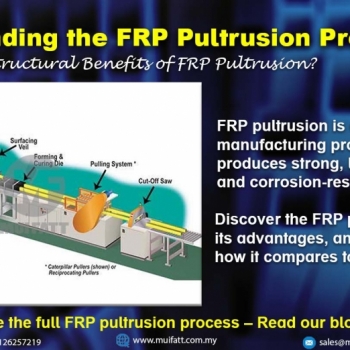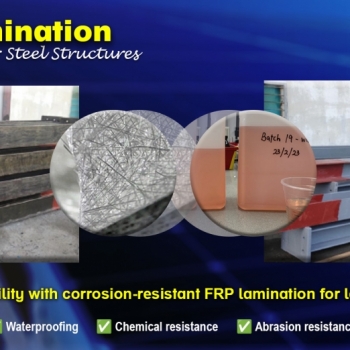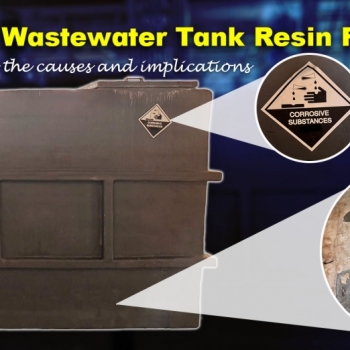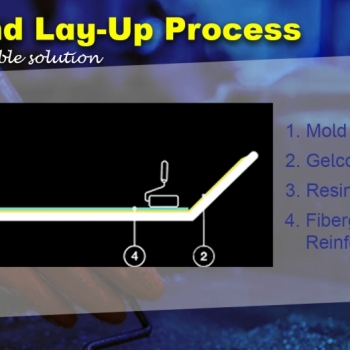FRP pultrusion is a continuous manufacturing process that produces strong, lightweight, and corrosion-resistant profiles. This article explains how the process works, its advantages, and how it compares to other FRP fabrication techniques, helping you choose the right material for your project.
Fiberglass-Reinforced Plastics (FRP) Secondary Containment Tank
15 May 2023
A double containment system and a secondary containment tank are related concepts in the context of environmental protection and containment of hazardous materials. What are they? What is the difference between them? And what is the relationship between the two? Let’s dive into it.
What is Double Containment System?
 A double containment system is by definition an arrangement of a primary storage or transportation vessels (piping system, tank system, or a combined system), contained within a housing that provides a means of secondary containment of a fluid if the primary containment fails. It refers to a more comprehensive approach to containment, consisting of two layers or barriers of containment.
A double containment system is by definition an arrangement of a primary storage or transportation vessels (piping system, tank system, or a combined system), contained within a housing that provides a means of secondary containment of a fluid if the primary containment fails. It refers to a more comprehensive approach to containment, consisting of two layers or barriers of containment.
Generally, a double containment system typically consists of both a primary containment tank and a secondary containment tank. The primary containment tank is the inner tank that directly holds the substance being stored, such as chemicals, fuels, or other hazardous materials. It is designed to safely contain the substance and prevent leaks or spills under normal operating conditions.
The secondary containment tank, also known as the outer tank or containment structure, surrounds the primary tank and its transportation vessel. Its purpose is to provide an additional layer of protection and serve as a secondary barrier in the event of a leak or failure of the primary tank.
In essence, the secondary containment tank is an integral component of a double containment system. It serves as the outer layer of containment and is specifically designed to prevent the release of hazardous materials into the environment. The double containment system, with its primary container and secondary containment tank, offers an enhanced level of safety and environmental protection by minimizing the risk of leaks, spills, or releases and ensuring that any potential hazards are contained within the secondary barrier.
In this article, we will be explore the features, benefits, and safety considerations associated with secondary containment tank, particularly in the material of Fiberglass-Reinforced Plastics (FRP).
What is Secondary Containment Tank?
 A secondary containment tank is a storage system that act as a safeguard by providing an additional layer of protection. They help to contain leaks or spills in the event of failures of the primary storage tank. It shall be able to hold or contain hazardous substances, such as chemicals, fuels, or other potentially harmful materials, preventing the hazardous material from reaching the environment, water sources, or sensitive ecosystems. This containment minimizes the potential for harm to human health, wildlife, and surrounding communities. Hence, they are typically larger in size than the primary tank with a capacity that is able to hold a specific volume of the material being stored and is constructed of materials that are resistant to corrosion and can withstand the stored substance’s potential effects.
A secondary containment tank is a storage system that act as a safeguard by providing an additional layer of protection. They help to contain leaks or spills in the event of failures of the primary storage tank. It shall be able to hold or contain hazardous substances, such as chemicals, fuels, or other potentially harmful materials, preventing the hazardous material from reaching the environment, water sources, or sensitive ecosystems. This containment minimizes the potential for harm to human health, wildlife, and surrounding communities. Hence, they are typically larger in size than the primary tank with a capacity that is able to hold a specific volume of the material being stored and is constructed of materials that are resistant to corrosion and can withstand the stored substance’s potential effects.
Furthermore, secondary containment is often required by regulatory agencies and industry standards to ensure compliance with environmental and safety regulations. It demonstrates a commitment to responsible storage practices and mitigating the potential impact of hazardous materials.
Secondary containment tank often serves as a crucial safety measure. Particularly in relative industries, they are designed to meet specific regulatory requirements and safety standards to ensure the integrity of the stored materials.
Who required the use of Double Containment System?
In industries dealing with chemicals, fuels, oils, and other hazardous substances.
What kind of material is suitable to fabricate this special requirement tanks?
In the market, common materials used for secondary containment tanks include concrete, steel or fiberglass (FRP). Above all, Fiberglass-Reinforced Plastic (FRP) is commonly used as a material for secondary containment tanks because of its features.
Understanding Fiberglass-Reinforced Plastics (FRP) Secondary Containment Tank
 Fiberglass-Reinforced Plastics (FRP) secondary containment tank are widely used in industries dealing with chemicals, fuels, and other hazardous materials. They offer several advantages, including excellent corrosion resistance, durability, and long service life. The lightweight nature of FRP simplifies installation and transportation, reducing construction costs. Additionally, FRP allows for design flexibility, enabling customization to suit specific project requirements.
Fiberglass-Reinforced Plastics (FRP) secondary containment tank are widely used in industries dealing with chemicals, fuels, and other hazardous materials. They offer several advantages, including excellent corrosion resistance, durability, and long service life. The lightweight nature of FRP simplifies installation and transportation, reducing construction costs. Additionally, FRP allows for design flexibility, enabling customization to suit specific project requirements.
Benefits of Fiberglass-Reinforced Plastics (FRP) Secondary Containment Tank
Superior Strength and Durability
FRP materials offer exceptional strength-to-weight ratio, making them an ideal choice for constructing double containment system - secondary containment tank. Fiberglass reinforcement provides high tensile strength, allowing the tank to withstand external pressures, mechanical stress, and extreme weather conditions.
Corrosion Resistance
One of the key advantages of fiberglass is its exceptional resistance to corrosion. FRP secondary containment tank are highly resistant to a wide range of corrosive chemicals, acids, and alkalis, ensuring long-term durability and preventing leaks or material degradation.
Environmental Protection
By incorporating double containment, these tanks provide an additional layer of environmental protection. In the event of a leak or spill in the primary tank, the secondary tank acts as a secondary barrier, containing the hazardous substance and preventing it from escaping into the environment. This helps minimize the risk of soil or groundwater contamination, effectively eliminating last-minute water cut-off incident, which greatly affect people’s daily lives.
Versatility and Customization
FRP secondary containment tank can be custom-designed to meet specific storage requirements. They can be manufactured in various sizes, shapes, and configurations to accommodate different volumes and site constraints. This versatility allows for optimal utilization of available space and ensures an efficient storage solution.
Safety Considerations relating to Fiberglass-Reinforced (FRP) Secondary Containment Tanks
Proper Installation and Maintenance
 Ensuring proper installation and regular maintenance of FRP secondary containment tank is crucial for their effectiveness and longevity. Following manufacturer guidelines, employing trained professionals, and conducting routine inspections are essential to identify and address any potential issues or wear and tear.
Ensuring proper installation and regular maintenance of FRP secondary containment tank is crucial for their effectiveness and longevity. Following manufacturer guidelines, employing trained professionals, and conducting routine inspections are essential to identify and address any potential issues or wear and tear.
Compliance with Regulatory Standards
Adherence to relevant regulatory standards and guidelines is vital when working with hazardous substances. It is imperative to comply with local and national regulations governing the design, installation, and operation of secondary containment tank. In Malaysia, compliance with Department of Occupational Safety and Health (DOSH) requirements is essential for maintaining a safe and compliant workplace.
Training and Emergency Preparedness
Proper training and education of personnel involved in handling and operating secondary containment tank are paramount. Workers should be trained on emergency response procedures, spill containment, and leak detection mechanisms. Adequate emergency equipment, such as spill kits and containment barriers, should be readily available to respond promptly to any potential incidents.
As a conclusion, FRP secondary containment tank offer a robust and reliable solution for the storage of hazardous substances. Their superior strength, corrosion resistance, and environmental protection properties make them a preferred choice across various industries. By adhering to proper installation, maintenance, and regulatory compliance, these tanks can provide a safe and secure storage environment while minimizing the risk of environmental contamination. Investing in FRP secondary containment tank demonstrates a commitment to worker safety, environmental stewardship, and regulatory compliance.
Talk to us for your project today! WhatsApp or email – sales@muifatt.com.my
We guarantee our expertise to you.
Visit our product page for more product details – Fiberglass-Reinforced Plastic (FRP) Double Containment Tank
Disclaimer:-
The information provided on this website is for general informational purposes only and does not constitute legal advice. While we strive to ensure the accuracy and reliability of the information provided, we make no representations or warranties of any kind, express or implied, about the completeness, accuracy, reliability, suitability, or availability concerning the information contained herein. Any reliance you place on such information is therefore strictly at your own risk. This website may contain links to other third-party websites. Such links are only for the convenience of the reader, user, or browser; which we do not warrant, recommend, endorse, or assume liability for the contents of the third-party sites.
Keep in touch with us should you be keen on receiving timely updates from us
- Website - https://www.muifatt.com.my/home/
- Facebook - https://www.facebook.com/muifattmarketing
- Instagram - https://www.instagram.com/muifattmarketing/
- Google - https://goo.gl/maps/WxVY13gNcaRTS7Jp6
- Youtube - http://www.youtube.com/@MuiFattMarketing
- TikTok - https://www.tiktok.com/@muifattmarketing
- LinkedIn - https://www.linkedin.com/company/mui-fatt-marketing-sdn-bhd-
- Linktree - https://linktr.ee/muifattmarketing
- Shopee - https://www.shopee.com.my/muifattmarketing
- Lazada - https://www.lazada.com.my/shop/mui-fatt-marketing
Recent Blog
The Ultimate Guide to Locking Mechanisms for FRP Molded Grating
Understanding the right locking method for FRP molded grating is crucial for safety and durability. Learn about M clips, J clips, C clips, and disk plates, along with installation recommendations to ensure a secure and stable grating system.
Enhancing Solar Panel Fixing Structures with FRP Lamination: A Corrosion Barrier Solution
An expert look at how FRP lamination acts as a corrosion barrier for solar panel fixing structures, offering advanced protection and sustainability benefits.
Steel Fixing Structures in Solar Panel Installations: Corrosion Challenges and Alternative Materials
An in-depth look at the corrosion challenges faced by steel solar panel fixing structures and alternative materials that offer enhanced durability and sustainability.
The Essential Guide to Kickplates: Safety, Style & Compliance
Learn why kickplates matter for safety, style, and compliance. Discover how they improve accessibility and meet building code requirements.
The Costly Mistake of Using Unsuitable Resin for FRP Tanks
Explore the risks of unsuitable resins for FRP wastewater tanks, including a real-life example of NaOH corrosion. Learn how to avoid costly failures.
Mastering the FRP Hand Lay-Up Process: Methods, Benefits, Sustainability
Discover the FRP hand lay-up manufacturing process, its importance, differences from other methods, and how it aligns with your custom project needs.
Transform DIY Projects with FRP Pultruded Profiles
Explore the versatility of FRP pultruded profiles and how they can elevate your DIY landscaping projects. Get inspired by Mui Fatt's successful applications and learn how to create custom solutions for small- to larger-scale projects.
